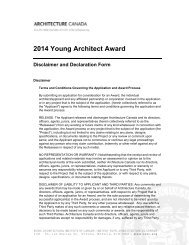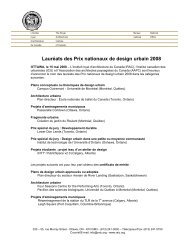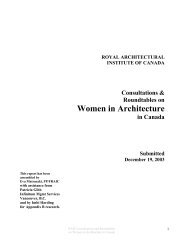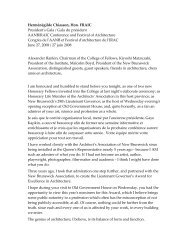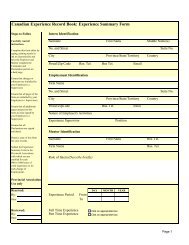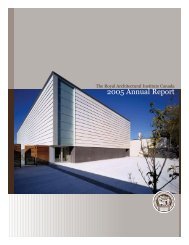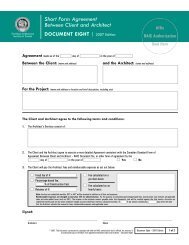Benchmark Study on Green Buildings - Royal Architectural Institute ...
Benchmark Study on Green Buildings - Royal Architectural Institute ...
Benchmark Study on Green Buildings - Royal Architectural Institute ...
Create successful ePaper yourself
Turn your PDF publications into a flip-book with our unique Google optimized e-Paper software.
council has said that the municipal water department will pay developers $10/m 2 of green<br />
roof installed. This is likely to cover between 10 and 20% of the total green roof costs,<br />
which is not much but at least it is something. This pilot project has a meager fund of<br />
$200,000, which is not likely to cover more than a few dozen buildings. However, this is<br />
still progress, and is <strong>on</strong>e of the reas<strong>on</strong>s North American installati<strong>on</strong>s of green roofs are<br />
increasing at a rate of more than 70% a year.<br />
B-3 Germany:<br />
German Renewable Energy Law (EEG) & informati<strong>on</strong>:<br />
In terms of its overall c<strong>on</strong>cern for the envir<strong>on</strong>ment, Germany is <strong>on</strong>e of the leading<br />
countries in the world for several reas<strong>on</strong>s. The German Renewable Energy Law (EEG)<br />
was passed in 2000 and updated in early 2004. Above-market revenues are charged for<br />
green power sales and the cost is spread am<strong>on</strong>g all c<strong>on</strong>sumers, to minimize the overall<br />
effect of the cost increase. All renewable energy produced is c<strong>on</strong>sumed at a higher price<br />
to encourage the development and generati<strong>on</strong> of more renewable power. The goal is that<br />
technological improvements will gradually drive prices down, slowly reducing the tariffs<br />
paid to the producers of renewable energy, but that by then, renewable energy producti<strong>on</strong><br />
will be increasingly possible, prevalent and affordable. The EEG is a medium- to l<strong>on</strong>gterm<br />
strategy designed to increase the amount of renewable energy produced in Germany,<br />
and make it more affordable and widespread over time.<br />
As a result of the EEG, Germany is the fastest-growing market for photovoltaics in the<br />
world, worth over 800 milli<strong>on</strong> euros in 2003 (about $1.15 billi<strong>on</strong> Canadian) and<br />
1.8 billi<strong>on</strong> euros in 2004 (about $2.55 billi<strong>on</strong> Canadian). The German solar power<br />
industry grew 53% to 837 megawatts of energy in 2005, representing 57% of total world<br />
solar energy output. In late 2004, Germany began operating the world’s largest solar<br />
power plant in Mulhausen. The plant generates 6.3 megawatts of power, and is part of a<br />
set of facilities in Bavaria which will produce a total of 10 megawatts of power using<br />
57,600 silic<strong>on</strong> solar panels up<strong>on</strong> completi<strong>on</strong>. Another 10 megawatts of solar power<br />
generati<strong>on</strong> will be coming <strong>on</strong>line so<strong>on</strong> in another four-locati<strong>on</strong> project. Bey<strong>on</strong>d solar,<br />
Germany is also the world’s leading producer of wind power, with over 16,000 windmills.<br />
Power generati<strong>on</strong> capacity from wind amounted to 14,609 megawatts in 2003, up from<br />
334 megawatts in 1993. Renewable sources currently produce more than 10% of the<br />
nati<strong>on</strong>’s energy, a level which is supposed to double by 2020 and reach 50% by 2050.<br />
However, at the current pace of development, it will likely reach this goal so<strong>on</strong>er than<br />
that; as of projecti<strong>on</strong>s from 2000, the 10% mark was not supposed to be obtained until<br />
2010.<br />
KfW Federal Bank CO 2 Building Modernizati<strong>on</strong> Program & CO 2 Reducti<strong>on</strong> Program:<br />
Germany is c<strong>on</strong>sidered to be am<strong>on</strong>g the leaders of the global green building initiative<br />
because of its “can-do” attitude and dem<strong>on</strong>strated ability to set envir<strong>on</strong>mental goals,<br />
provide flexibility, and offer incentives for homeowners, builders and developers to build<br />
greener buildings. One of Germany’s largest financial green building incentives is the<br />
KfW Federal Bank’s ‘CO 2 Building Modernizati<strong>on</strong> Program.’ Introduced in January 2001<br />
as part of the Government's Climate Change Program and revamped in 2003, the KfW<br />
offers loans at preferential rates to home owners, housing authorities, local authorities, etc<br />
71



